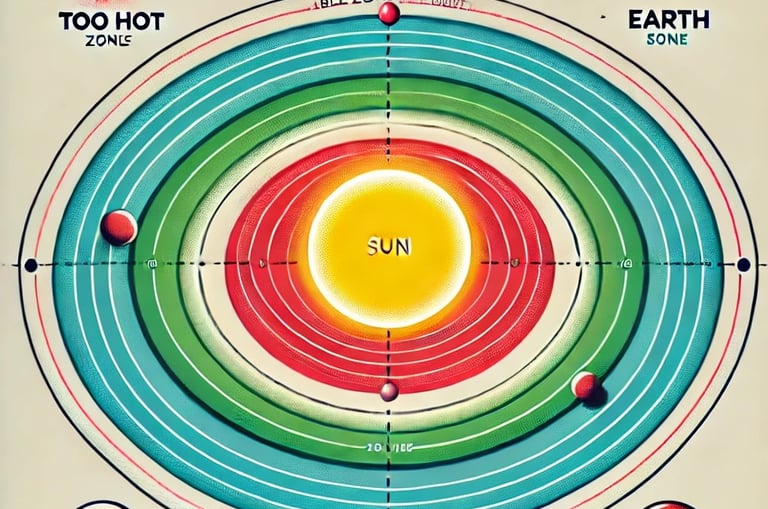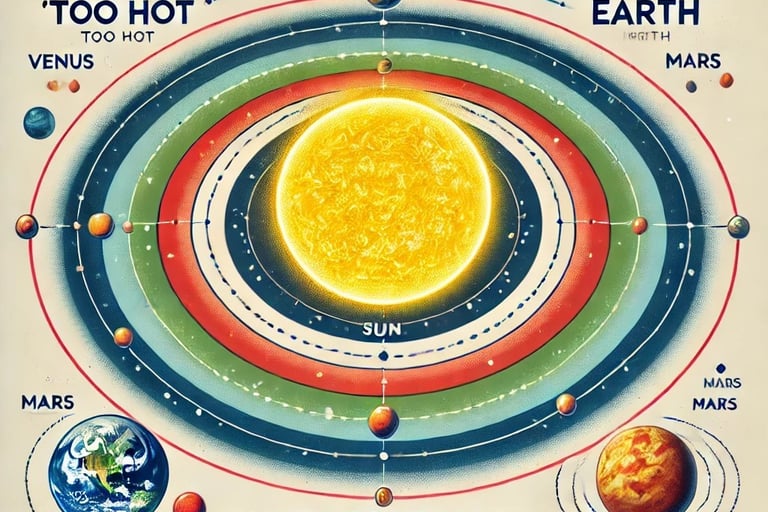The Goldilocks Zone: Earth, Exoplanets, and the Search for Life
In the vast expanse of the universe, the Goldilocks Zone marks the delicate boundary where life-sustaining conditions thrive. From Earth to distant exoplanets, the search for another home continues—are we the exception or just one of many?
CURIONIS


For centuries, humans have looked up at the night sky, wondering if another world like Earth exists—a place where life could thrive. In astronomy, this search centres around the Goldilocks Zone, or the habitable zone, the region around a star where conditions are just right for liquid water to exist.
The name comes from the classic fairy tale Goldilocks and the Three Bears, where Goldilocks prefers things neither too hot nor too cold, but just right. Similarly, planets in this zone orbit at a distance where they are neither scorched nor frozen, offering the potential for life as we know it. But is distance alone enough?
Earth: The Perfect Balance in the Goldilocks Zone
Earth sits right in the middle of the Sun’s habitable zone, receiving the precise amount of heat and light needed to sustain liquid water. Yet, its habitability is not just about location—it’s a result of a perfect cosmic balance:
Atmosphere & Greenhouse Effect: The right mix of gases maintains a stable climate.
Magnetic Field: Shields the planet from harmful solar radiation.
Geological Activity: Plate tectonics regulate carbon levels, preventing extreme temperature swings.
The Moon’s Influence: Helps stabilize Earth’s tilt, ensuring consistent seasons.
Nearby, Venus—though technically within the habitable zone—became a scorching inferno due to a runaway greenhouse effect, while Mars, at the outer edge, lost its atmosphere and dried up. Clearly, just being in the right place isn’t enough—other planetary factors determine if a world can truly support life.
Exoplanets in the Goldilocks Zone: Earth's Potential Cousins
Beyond our solar system, astronomers have discovered thousands of exoplanets, and among them, a few stand out as possible Earth-like worlds. While their true nature remains uncertain, they offer glimpses of what might be possible:
1. Kepler-442b: A Leading Candidate
Orbits in the centre of its star’s habitable zone, making it one of the most promising candidates for habitability.
Distance: 1,206 light-years.
2. Kepler-186f: The First Earth-Sized Planet in a Habitable Zone
The first confirmed Earth-sized exoplanet in a habitable zone, though its red dwarf star could pose challenges.
Distance: 500 light-years.
3. Kepler-22b: A Possible Ocean World
May have a global ocean, though its thick atmosphere could make it too warm.
Distance: 600 light-years.
4. Proxima Centauri b: The Closest Exoplanet
The closest known exoplanet in a habitable zone, though its active star may strip away its atmosphere.
Distance: 4.24 light-years.
5. TOI-700 d: A Recent Discovery
A relatively stable habitable-zone planet around a red dwarf, better suited for further study.
Distance: 101 light-years.
6. TRAPPIST-1 System: A Family of Possibilities
Hosts seven Earth-sized planets, three of which lie in the habitable zone—an unprecedented discovery in exoplanet research.
Distance: 40 light-years.
While these planets sit in their star’s Goldilocks Zone, their actual habitability depends on many factors: atmospheric composition, surface conditions, and host star activity. Some may be welcoming worlds, while others may be desolate and hostile.
The habitable zone is just a starting point. Some moons in our own solar system—like Europa and Enceladus—lie outside this zone but have vast subsurface oceans, warmed by internal forces. This suggests that life could exist beyond traditional boundaries, reshaping our understanding of what makes a world habitable.
For now, Earth remains the only known oasis of life—a fragile blue world, perfectly placed in the Goldilocks Zone. But the cosmos tells us that our planet is not unique in its conditions. With every discovery—whether a potential ocean world or a rocky Earth-sized planet—we inch closer to answering the age-old question:
With telescopes like the James Webb Space Telescope (JWST) and upcoming missions focused on exoplanet atmospheres, we stand at the threshold of a profound revelation. We may soon confirm the presence of biosignatures—chemical markers of life—on a distant world.
If another Earth-like planet exists, it would mean life is not an anomaly but a natural outcome of the universe’s vast expanse. And if life can emerge elsewhere, then perhaps the cosmos is teeming with worlds waiting to be discovered, stories waiting to be told.
Until then, our home remains a rare jewel in the dark, reminding us of our place in an ever-expanding mystery—one where the next chapter may reveal that life is far more abundant than we ever imagined.
Subhalakshmi Buragohain
Hyderabad
Can you spot the Goldilocks Zone, where life finds a chance?


The green region marks the habitable zone, where conditions are just right for liquid water—and possibly, life—to exist.
